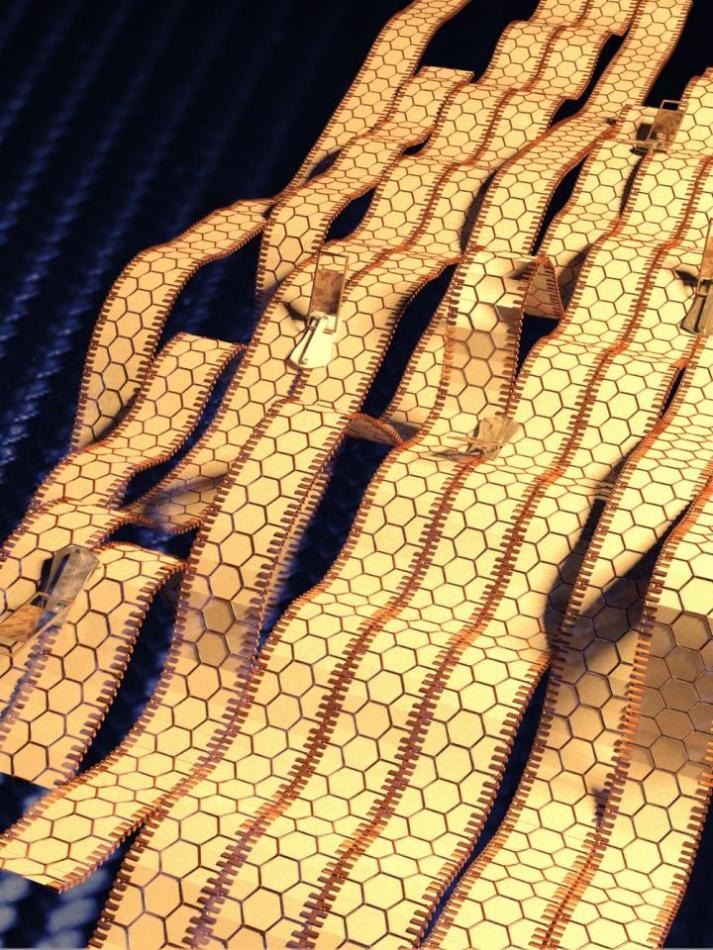Oct 20 2016
 Faulty 'zipping' of polymer-based ribbons can lead to formation of D-loops in graphitic sheets of carbon fibers, according to scientists at Rice University. (CREDIT:Nitant Gupta and Evgeni Penev/Rice University)
Faulty 'zipping' of polymer-based ribbons can lead to formation of D-loops in graphitic sheets of carbon fibers, according to scientists at Rice University. (CREDIT:Nitant Gupta and Evgeni Penev/Rice University)
For decades, carbon fiber has been considered as a pillar of strength in the field of materials manufacturing. Rice University scientists are now finding ways to improve these carbon fibers to enhance its properties.
The scientists discovered that the polymer chains that develop a common carbon fiber are susceptible to misalignment during the manufacturing process. This misalignment is considered as a defect that the researchers compared to a faulty zipper that leads to weakening of the product.
The Rice laboratory of theoretical physicist Boris Yakobson is currently involved in analyzing these ignored defects and is also suggesting ways to overcome these defects. This study appears in the October, 2016 issue of Advanced Materials.
Although serious developments in the field of carbon fiber were not made until the late ‘50s, during the 19th century Thomas Edison made filaments for his prototype lightbulbs using fabricated carbon fibers. Carbon fibers are flexible, rugged, heat-resistant, conductive and also chemically inert. These fibers are generally used in bicycle frames, tennis rackets, aircraft and many other products. If light and tough fabrics are needed, then carbon fibers can be spun into yarn.
Although well-established and mature, the field of carbon fibers has largely remained inert to using and benefiting from the intensive theoretical development in the 'young' field of low-dimensional nanocarbon.
Evgeni Penev, Research Scientist, Rice University
In order to reduce the defects in various extensively used carbon fiber manufacturing processes, the scientists built computer models that can forecast the occurrence of defects. For instance, while heating polyacrylonitrile (PAN) at 1,500°C, the heat burns off all of the carbon atoms except the strongly bound carbon atoms. As a result, they get converted into rudimentary graphene nanoribbons that are aligned in such a manner that stops the nanoribbons from easily zipping into graphene's honeycomb lattice.
Yakobson acquired the idea of this misfusion in fiber synthesis while reading a biology paper that dealt with D-loops in RNA transcription. Yakobson felt that such defects might be unavoidable in PAN-made carbon fiber also.
It took a lot of work after that to determine their place and mechanical consequences in the fiber context.
Boris Yakobson, Theoretical Physicist, Rice Universty
Molecular dynamics simulations display that misfusion clasped the individual polymer chains and formed D-loops. These loops are the preliminary limiting constraints of carbon fiber's vaunted strength. Researchers state that, the theoretical estimates of fiber strength effectively dropped closer to what has been observed experimentally and also that its strength reduced by up to a factor of four.
"To me, the most intriguing part was realizing that D-loop defects enable the possibility of very large Burgers vectors, which are almost impossible in 3-D materials and would have been an absurd idea to even consider," said Nitant Gupta, a Rice graduate student and the paper's lead author. Burgers vectors are factors that help in tracking the measure of the strength-influencing distortions that occur due to dislocations in a crystal lattice.
Scientists were surprised to notice that the strength of the fiber enhanced despite D-loops’ presence when the PAN chains misaligned with the fiber axis.
Scientists also found that D-loops can be entirely prevented by starting with graphene nanoribbons instead of PAN. As D-loops are likely to be the starting spot for cracks, according to simulations, getting rid of as many D-loops as possible will only enhance the fiber's strength.
Aside from specifics, we like to see this work as an attempt to cross-fertilize these fields at an atomistic-modeling level. We hope this will provide added value to those working in the field and eventually to a much broader audience.
Evgeni Penev, Research Scientist, Rice University
Rice alumnus Vasilii Artyukhov, a former postdoctoral researcher, is the co-author of the paper. Yakobson is the Karl F. Hasselmann Professor of Materials Science and NanoEngineering and a professor of chemistry.
The National Science Foundation-supported DAVinCI supercomputer and Night Owls Time-Sharing Service administered by Rice’s Center for Research Computing were used. These supercomputers were procured during a partnership with Rice’s Ken Kennedy Institute for Information Technology. The U.S. Air Force Office of Scientific Research supported this research program.